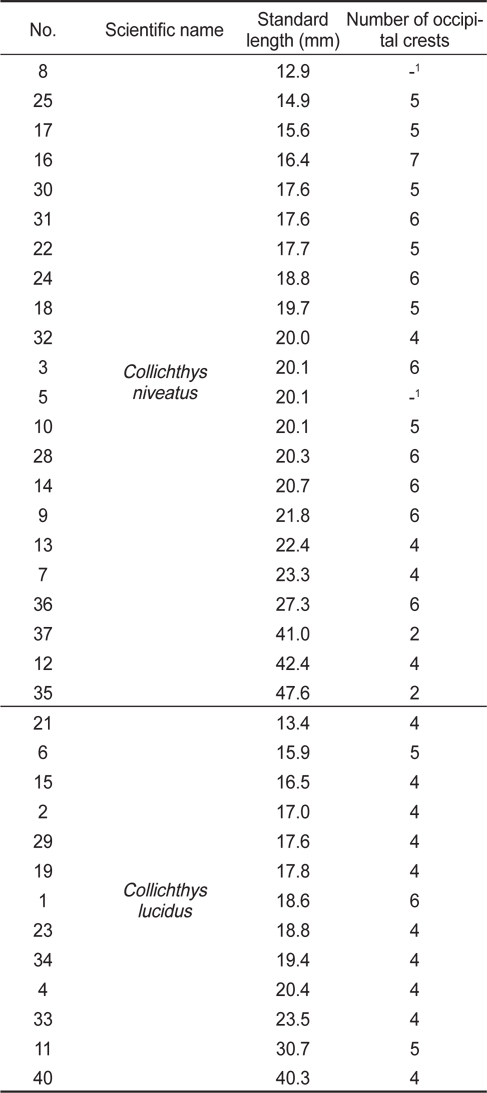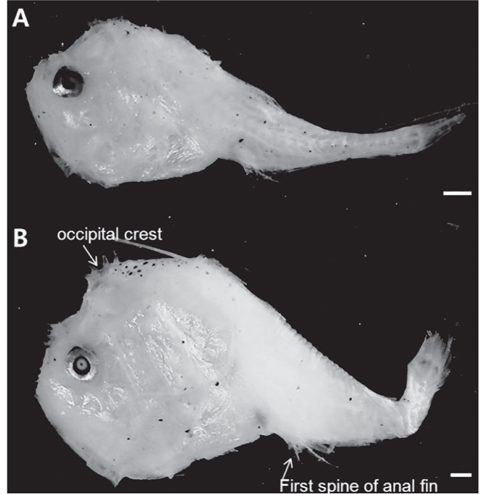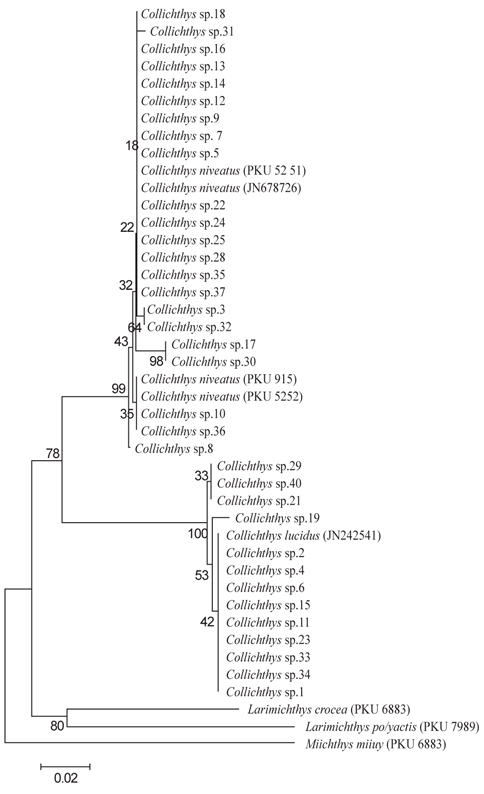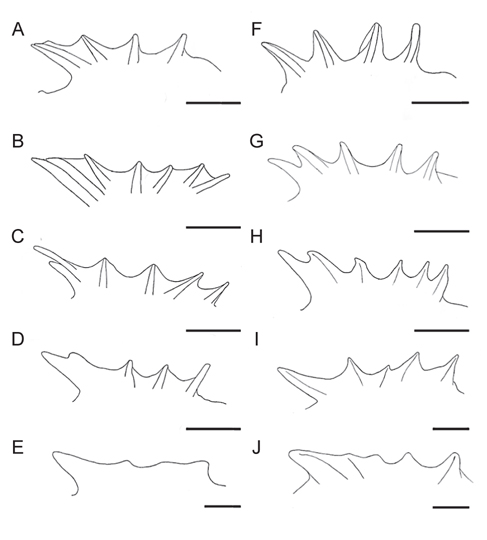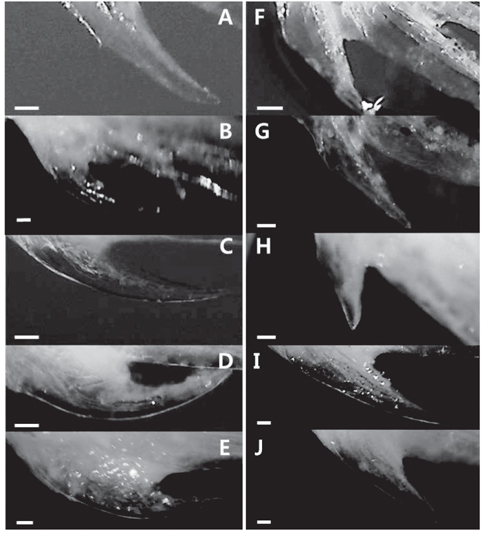어류의 치어단계는 어류의 생활사 중에서 매우 중요하며, 치어 단계에서의 생존은 성어자원으로의 가입에 큰 영향을 미친다(Heupel et al. 2007). 이러한 중요성 때문에 최근 치어나 유어에 대한 연구가 비교적 활발히 이루어지고 있다(Kim and Kim, 2002; Kim et al., 2010; Kim and Park, 2012; Lee and Kim, 2013).
민어과(Family Sciaenidae), 강달이속(Genus Collichthys) 어류는 전 세계적으로 2종(눈강달이 Collichthys niveatus, 황강달이 Collichthys lucidus)이 알려져 있으며(Froese and Pauly, 2013), 국내에는 주로 서해안에 2종이 서식한다(Im et al., 2009; Kim, 2011). 강달이속 2종은 형태적으로 매우 유사하여 식별이 어렵지만 두정부에 나 있는 볏모양의 돌기 수(눈강달이는 2개, 황강달이는 4개)와 뒷지느러미 제1극조의 모양(눈강달이는 활모양, 황강달이는 직선모양)으로 구분 가능하다(Lee, 1992; Nakabo, 2002; Kim et al.,2004; Kim et al.,2005). 강달이속 2종은 황해, 동중국해, 발해에 서식하며(Yamada et al., 2009), 산란기는 황강달이(5-6월)가 눈강달이(6-7월)보다 조금 빠른것으로 알려져 있다(Kim et al., 2004). 전남 S수협에 의하면 1999-2001년간 강달이속 위판량은 6-7월에 최고치를 보이며, 이는 강달이속 어류가 산란을 위해 봄에 연안으로 회유하면서 많이 어획되는 것 같다(NFRDI, 2000, 2001). 이처럼 서해 일부지역에서 강달이속 친어자원에 대한 어획이 집중되는 현상 때문에 이들 자원의 감소 또는 붕괴가 우려된다. 하지만 강달이속 2종의 생태 및 계통유연관계에 관한 연구가 중국에서 수행된바 있을 뿐(Cheng et al., 2011; Xu et al., 2011; Song et al., 2014) 국내에는 전무하여 형태 및 생태정보가 매우 부족한 실정이다. 따라서, 본 연구는 강달이속 어류의 합리적인 관리방안을 마련하기 위한 기초연구로서 치어기 강달이속 2종의 분류형질을 파악하는데 목적이 있다.
2012년 7-9월, 강화도 주변해역에서 낭장망으로 강달이속 치어를 채집하였으며(Fig. 1), 채집즉시 99% 에틸알코올(EtOH)에 고정하였고, 이중 상태가 양호한 35개체를 대상으로 분자동정 및 형태비교를 실시하였다. Genomic DNA는 치어의 오른쪽 눈(eyeball)을 이용하여 DNA 추출 Kit (AccuPrep®, Bioneer, Korea)로 추출하였다. 미토콘드리아 DNA Cytochrome c oxidase subunit I (COI) 영역은 Ward et al. (2005)의 VF2, FishR1 primer를 이용하여 증폭하였으며, 연쇄중합효소반응(Polymerase Chain Reaction; PCR) 조건은 다음과 같다; [Initial denaturation 95℃에서 5분; PCR reaction 35cycles (denaturation 95℃에서 1분, annealing 50℃에서 1분, extension 72℃에서 1분); final extension 72℃에서 5분]. PCR 산물은 DavinchTM PCR 정제 Kit (Davinch-K, Korea)를 이용하여 정제하였다. 염기서열은 ABI 3730XL sequencer (Applied Biosystems, USA)과 ABI PRISMR BigDyeTM Terminator v3.0 Ready Reaction Cycle Sequencing Kit (Applied Biosystems, USA)를 이용하여 얻었다. 염기서열 정렬은 BioEdit version 7 (Hall, 1999)의 ClustalW (Thompson et al., 1994)를 이용하였으며, 염기서열 비교는 부경대학교(PKU) 어류학실험실과 National Center for Biotechnology Information (NCBI)에 등록된 눈강달이 및 황강달이 염기서열을 이용하였다. 유전거리는 MEGA version 5 (Tamura et al. 2011)의 Pairwise distance를 Kimura-2-parameter 모델(Kimura, 1980)로 계산하였다. Neighbor joining tree는 MEGA version 5 (Tamura et al., 2011)에서 작성하였으며, bootstrap은 1000번 수행하였다.
강달이속 치어의 외부형태는 성어의 분류형질인 두정부의 볏모양 돌기수(number of occipital crest) 및 뒷지느러미 제1가시의 모양(Kim et al., 2004; Kim et al., 2005)을 조사하였다. 외부형태는 입체해부현미경(Olympus SZX-16, Japan) 아래에서 관찰하였으며, 현미경에 부착된 카메라(Moticam pro 205A, China)를 이용하여 사진 촬영하였다. 체장(Standard length; SL)은 버니어캘리퍼스를 이용하여 0.1 mm 단위까지 측정하였다. 분류체계 및 학명은 Froese and Pauly (2013)을 따랐다. 분석이 끝난 시료는 부경대학교 어류학실험실에 등록, 보관하였다(PKUI 28, PKUI 154-187).
강달이속 치어 35개체의 mtDNA COI 327 bp가 성공적으로 증폭되었으며 이를 부경대학교 및 NCBI에 등록된 민어과 어류와 비교한 결과, 13개체는 황강달이, 22개체는 눈강달이로 동정되었으며, 종간 평균 유전적 거리는 0.096으로 나타났다. 또한, 강달이속 2종과 라강달이속(Genus Larimichthys) 2종(참조기 Larimichthys polyactis, 부세 Larimichthys crocea)은 각각 잘 구분되어 유집되었다(Fig. 2). 형태적으로 성어기에 강달이속 두종을 구분하는 유용한 분류형질로 두정부의 볏모양 돌기수(눈강달이는 2개, 황강달이는 4개)가 알려져 있다(Lee, 1992; Nakabo, 2002; Kim et al., 2004; Kim et al., 2005). 그러나, 본 조사에서 치어기에는 두정부의 볏모양 돌기수가 두종을 구분짓지 못하였다. 두정부의 볏모양 돌기수는 눈강달이 치어(12.9-47.6 mm in SL, n=22)가 2-7개, 황강달이 치어(13.4-40.3 mm in SL, n=13)가 4-6개로 중복되는 경향을 보였다. 그러나, 눈강달이 치어는 대체로 5개 이상의 두정부 볏모양 돌기를 가지는 반면, 황강달이 치어는 주로 4개를 가져 출현-빈도에서 차이를 나타내었다(Fig. 3, Table 1). 또한, 눈강달이 치어중 체장 41.0 mm, 47.6 mm의 최대 개체에서 2개의 두정부 볏모양 돌기를 가져 이 시기에 두정부 볏모양 돌기수가 성어의 것과 비슷해 지는 것으로 추정된다. 한편, 성어기에 강달이속 두종은 뒷지느러미 제1가시의 모양(눈강달이는 활모양, 황강달이는 직선모양)에서 잘 구분된다(Lee, 1992; Nakabo, 2002; Kim et al., 2004; Kim et al., 2005). 본 연구 결과, 성어기와 마찬가지로 치어기에 두종은 뒷지느러미 제1가시의 모양에서 잘 구분되었다. 즉, 눈강달이는 뒷지느러미 제1가시의 앞, 뒷가장자리가 모두 활처럼 휘어 있지만, 황강달이는 앞가장자리만 휘어 있고 뒷가장자리는 직선 모양이었다. 또한, 두종은 성장함에 따라 뒷지느러미 제1가시의 모양이 변하는데, 눈강달이의 경우 성장하면서 초승달처럼 심하게 휘는 반면, 황강달이는 직선 모양으로 변하였다(Fig. 4). 따라서, 본 연구는 강달이속 두종이 치어기(13.4-40.3 mm in SL)에 두정부의 볏모양 돌기수로는 구분이 어렵지만, 뒷지느러미 제1가시의 모양으로는 구분이 가능함을 알 수 있었다. 최근, Song et al. (2014)은 중국산 황강달이가 유전적으로 2개의 집단을 형성하는 것으로 보고한 바 있는데, 한국산 강달이속 2종에 대해서도 관리단위(범위)를 명확히 하기 위해 집단유전학적 연구가 필요한 것으로 사료된다.




